Jiefeng Li
GENMO: A GENeralist Model for Human MOtion
May 02, 2025Abstract:Human motion modeling traditionally separates motion generation and estimation into distinct tasks with specialized models. Motion generation models focus on creating diverse, realistic motions from inputs like text, audio, or keyframes, while motion estimation models aim to reconstruct accurate motion trajectories from observations like videos. Despite sharing underlying representations of temporal dynamics and kinematics, this separation limits knowledge transfer between tasks and requires maintaining separate models. We present GENMO, a unified Generalist Model for Human Motion that bridges motion estimation and generation in a single framework. Our key insight is to reformulate motion estimation as constrained motion generation, where the output motion must precisely satisfy observed conditioning signals. Leveraging the synergy between regression and diffusion, GENMO achieves accurate global motion estimation while enabling diverse motion generation. We also introduce an estimation-guided training objective that exploits in-the-wild videos with 2D annotations and text descriptions to enhance generative diversity. Furthermore, our novel architecture handles variable-length motions and mixed multimodal conditions (text, audio, video) at different time intervals, offering flexible control. This unified approach creates synergistic benefits: generative priors improve estimated motions under challenging conditions like occlusions, while diverse video data enhances generation capabilities. Extensive experiments demonstrate GENMO's effectiveness as a generalist framework that successfully handles multiple human motion tasks within a single model.
BLADE: Single-view Body Mesh Learning through Accurate Depth Estimation
Dec 11, 2024



Abstract:Single-image human mesh recovery is a challenging task due to the ill-posed nature of simultaneous body shape, pose, and camera estimation. Existing estimators work well on images taken from afar, but they break down as the person moves close to the camera. Moreover, current methods fail to achieve both accurate 3D pose and 2D alignment at the same time. Error is mainly introduced by inaccurate perspective projection heuristically derived from orthographic parameters. To resolve this long-standing challenge, we present our method BLADE which accurately recovers perspective parameters from a single image without heuristic assumptions. We start from the inverse relationship between perspective distortion and the person's Z-translation Tz, and we show that Tz can be reliably estimated from the image. We then discuss the important role of Tz for accurate human mesh recovery estimated from close-range images. Finally, we show that, once Tz and the 3D human mesh are estimated, one can accurately recover the focal length and full 3D translation. Extensive experiments on standard benchmarks and real-world close-range images show that our method is the first to accurately recover projection parameters from a single image, and consequently attain state-of-the-art accuracy on 3D pose estimation and 2D alignment for a wide range of images. https://research.nvidia.com/labs/amri/projects/blade/
From Prohibition to Adoption: How Hong Kong Universities Are Navigating ChatGPT in Academic Workflows
Oct 02, 2024Abstract:This paper aims at comparing the time when Hong Kong universities used to ban ChatGPT to the current periods where it has become integrated in the academic processes. Bolted by concerns of integrity and ethical issues in technologies, institutions have adapted by moving towards the center adopting AI literacy and responsibility policies. This study examines new paradigms which have been developed to help implement these positives while preventing negative effects on academia. Keywords: ChatGPT, Academic Integrity, AI Literacy, Ethical AI Use, Generative AI in Education, University Policy, AI Integration in Academia, Higher Education and Technology
COIN: Control-Inpainting Diffusion Prior for Human and Camera Motion Estimation
Aug 29, 2024



Abstract:Estimating global human motion from moving cameras is challenging due to the entanglement of human and camera motions. To mitigate the ambiguity, existing methods leverage learned human motion priors, which however often result in oversmoothed motions with misaligned 2D projections. To tackle this problem, we propose COIN, a control-inpainting motion diffusion prior that enables fine-grained control to disentangle human and camera motions. Although pre-trained motion diffusion models encode rich motion priors, we find it non-trivial to leverage such knowledge to guide global motion estimation from RGB videos. COIN introduces a novel control-inpainting score distillation sampling method to ensure well-aligned, consistent, and high-quality motion from the diffusion prior within a joint optimization framework. Furthermore, we introduce a new human-scene relation loss to alleviate the scale ambiguity by enforcing consistency among the humans, camera, and scene. Experiments on three challenging benchmarks demonstrate the effectiveness of COIN, which outperforms the state-of-the-art methods in terms of global human motion estimation and camera motion estimation. As an illustrative example, COIN outperforms the state-of-the-art method by 33% in world joint position error (W-MPJPE) on the RICH dataset.
ShapeBoost: Boosting Human Shape Estimation with Part-Based Parameterization and Clothing-Preserving Augmentation
Mar 02, 2024



Abstract:Accurate human shape recovery from a monocular RGB image is a challenging task because humans come in different shapes and sizes and wear different clothes. In this paper, we propose ShapeBoost, a new human shape recovery framework that achieves pixel-level alignment even for rare body shapes and high accuracy for people wearing different types of clothes. Unlike previous approaches that rely on the use of PCA-based shape coefficients, we adopt a new human shape parameterization that decomposes the human shape into bone lengths and the mean width of each part slice. This part-based parameterization technique achieves a balance between flexibility and validity using a semi-analytical shape reconstruction algorithm. Based on this new parameterization, a clothing-preserving data augmentation module is proposed to generate realistic images with diverse body shapes and accurate annotations. Experimental results show that our method outperforms other state-of-the-art methods in diverse body shape situations as well as in varied clothing situations.
Denoising Vision Transformers
Jan 05, 2024
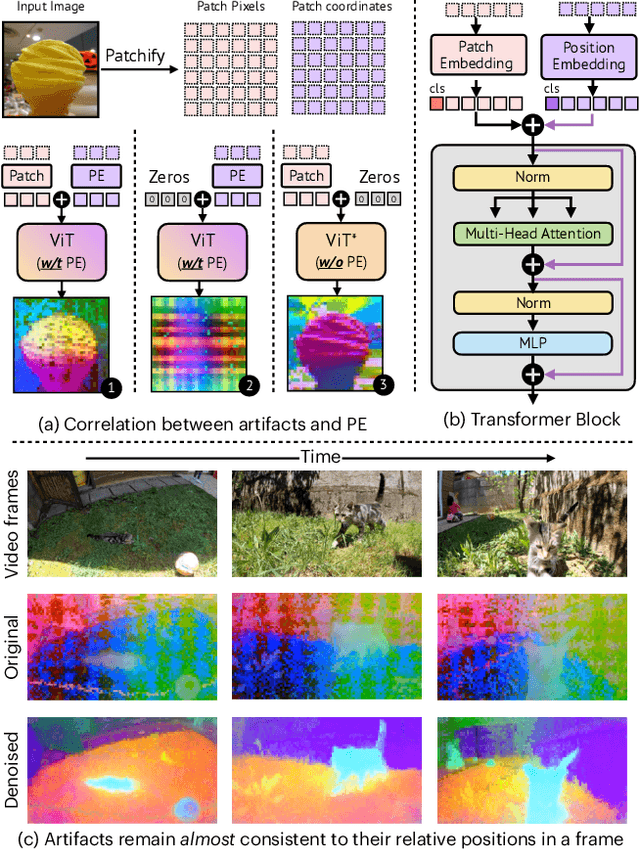
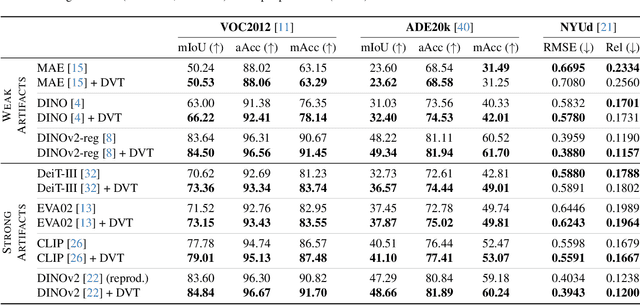
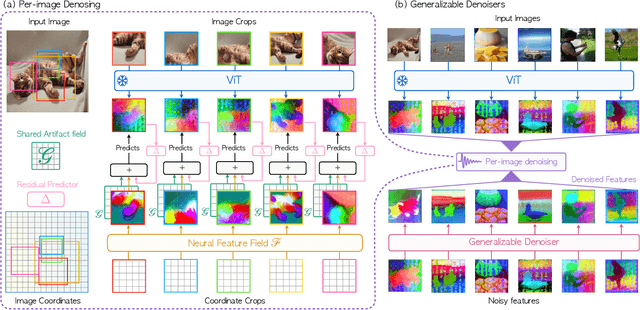
Abstract:We delve into a nuanced but significant challenge inherent to Vision Transformers (ViTs): feature maps of these models exhibit grid-like artifacts, which detrimentally hurt the performance of ViTs in downstream tasks. Our investigations trace this fundamental issue down to the positional embeddings at the input stage. To address this, we propose a novel noise model, which is universally applicable to all ViTs. Specifically, the noise model dissects ViT outputs into three components: a semantics term free from noise artifacts and two artifact-related terms that are conditioned on pixel locations. Such a decomposition is achieved by enforcing cross-view feature consistency with neural fields in a per-image basis. This per-image optimization process extracts artifact-free features from raw ViT outputs, providing clean features for offline applications. Expanding the scope of our solution to support online functionality, we introduce a learnable denoiser to predict artifact-free features directly from unprocessed ViT outputs, which shows remarkable generalization capabilities to novel data without the need for per-image optimization. Our two-stage approach, termed Denoising Vision Transformers (DVT), does not require re-training existing pre-trained ViTs and is immediately applicable to any Transformer-based architecture. We evaluate our method on a variety of representative ViTs (DINO, MAE, DeiT-III, EVA02, CLIP, DINOv2, DINOv2-reg). Extensive evaluations demonstrate that our DVT consistently and significantly improves existing state-of-the-art general-purpose models in semantic and geometric tasks across multiple datasets (e.g., +3.84 mIoU). We hope our study will encourage a re-evaluation of ViT design, especially regarding the naive use of positional embeddings.
NIKI: Neural Inverse Kinematics with Invertible Neural Networks for 3D Human Pose and Shape Estimation
May 15, 2023Abstract:With the progress of 3D human pose and shape estimation, state-of-the-art methods can either be robust to occlusions or obtain pixel-aligned accuracy in non-occlusion cases. However, they cannot obtain robustness and mesh-image alignment at the same time. In this work, we present NIKI (Neural Inverse Kinematics with Invertible Neural Network), which models bi-directional errors to improve the robustness to occlusions and obtain pixel-aligned accuracy. NIKI can learn from both the forward and inverse processes with invertible networks. In the inverse process, the model separates the error from the plausible 3D pose manifold for a robust 3D human pose estimation. In the forward process, we enforce the zero-error boundary conditions to improve the sensitivity to reliable joint positions for better mesh-image alignment. Furthermore, NIKI emulates the analytical inverse kinematics algorithms with the twist-and-swing decomposition for better interpretability. Experiments on standard and occlusion-specific benchmarks demonstrate the effectiveness of NIKI, where we exhibit robust and well-aligned results simultaneously. Code is available at https://github.com/Jeff-sjtu/NIKI
HybrIK-X: Hybrid Analytical-Neural Inverse Kinematics for Whole-body Mesh Recovery
Apr 12, 2023Abstract:Recovering whole-body mesh by inferring the abstract pose and shape parameters from visual content can obtain 3D bodies with realistic structures. However, the inferring process is highly non-linear and suffers from image-mesh misalignment, resulting in inaccurate reconstruction. In contrast, 3D keypoint estimation methods utilize the volumetric representation to achieve pixel-level accuracy but may predict unrealistic body structures. To address these issues, this paper presents a novel hybrid inverse kinematics solution, HybrIK, that integrates the merits of 3D keypoint estimation and body mesh recovery in a unified framework. HybrIK directly transforms accurate 3D joints to body-part rotations via twist-and-swing decomposition. The swing rotations are analytically solved with 3D joints, while the twist rotations are derived from visual cues through neural networks. To capture comprehensive whole-body details, we further develop a holistic framework, HybrIK-X, which enhances HybrIK with articulated hands and an expressive face. HybrIK-X is fast and accurate by solving the whole-body pose with a one-stage model. Experiments demonstrate that HybrIK and HybrIK-X preserve both the accuracy of 3D joints and the realistic structure of the parametric human model, leading to pixel-aligned whole-body mesh recovery. The proposed method significantly surpasses the state-of-the-art methods on various benchmarks for body-only, hand-only, and whole-body scenarios. Code and results can be found at https://jeffli.site/HybrIK-X/
AlphaPose: Whole-Body Regional Multi-Person Pose Estimation and Tracking in Real-Time
Nov 07, 2022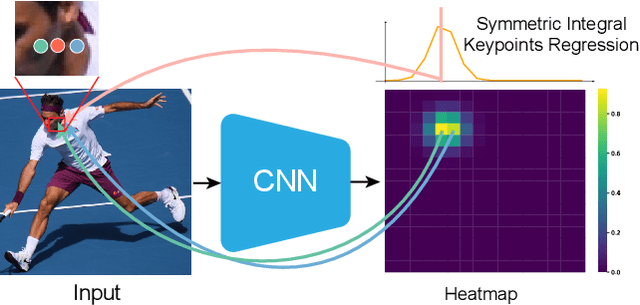
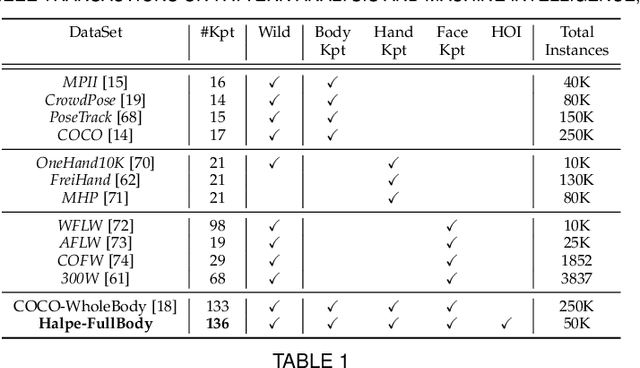
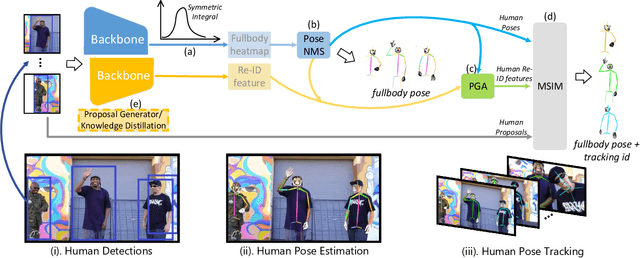
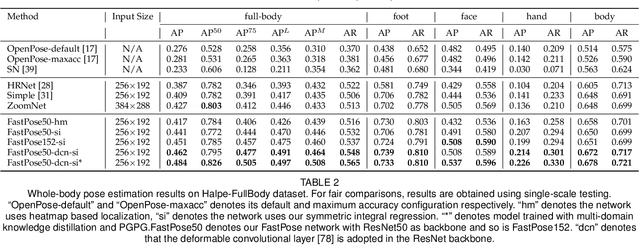
Abstract:Accurate whole-body multi-person pose estimation and tracking is an important yet challenging topic in computer vision. To capture the subtle actions of humans for complex behavior analysis, whole-body pose estimation including the face, body, hand and foot is essential over conventional body-only pose estimation. In this paper, we present AlphaPose, a system that can perform accurate whole-body pose estimation and tracking jointly while running in realtime. To this end, we propose several new techniques: Symmetric Integral Keypoint Regression (SIKR) for fast and fine localization, Parametric Pose Non-Maximum-Suppression (P-NMS) for eliminating redundant human detections and Pose Aware Identity Embedding for jointly pose estimation and tracking. During training, we resort to Part-Guided Proposal Generator (PGPG) and multi-domain knowledge distillation to further improve the accuracy. Our method is able to localize whole-body keypoints accurately and tracks humans simultaneously given inaccurate bounding boxes and redundant detections. We show a significant improvement over current state-of-the-art methods in both speed and accuracy on COCO-wholebody, COCO, PoseTrack, and our proposed Halpe-FullBody pose estimation dataset. Our model, source codes and dataset are made publicly available at https://github.com/MVIG-SJTU/AlphaPose.
D&D: Learning Human Dynamics from Dynamic Camera
Sep 19, 2022



Abstract:3D human pose estimation from a monocular video has recently seen significant improvements. However, most state-of-the-art methods are kinematics-based, which are prone to physically implausible motions with pronounced artifacts. Current dynamics-based methods can predict physically plausible motion but are restricted to simple scenarios with static camera view. In this work, we present D&D (Learning Human Dynamics from Dynamic Camera), which leverages the laws of physics to reconstruct 3D human motion from the in-the-wild videos with a moving camera. D&D introduces inertial force control (IFC) to explain the 3D human motion in the non-inertial local frame by considering the inertial forces of the dynamic camera. To learn the ground contact with limited annotations, we develop probabilistic contact torque (PCT), which is computed by differentiable sampling from contact probabilities and used to generate motions. The contact state can be weakly supervised by encouraging the model to generate correct motions. Furthermore, we propose an attentive PD controller that adjusts target pose states using temporal information to obtain smooth and accurate pose control. Our approach is entirely neural-based and runs without offline optimization or simulation in physics engines. Experiments on large-scale 3D human motion benchmarks demonstrate the effectiveness of D&D, where we exhibit superior performance against both state-of-the-art kinematics-based and dynamics-based methods. Code is available at https://github.com/Jeffsjtu/DnD
 Add to Chrome
Add to Chrome Add to Firefox
Add to Firefox Add to Edge
Add to Edge